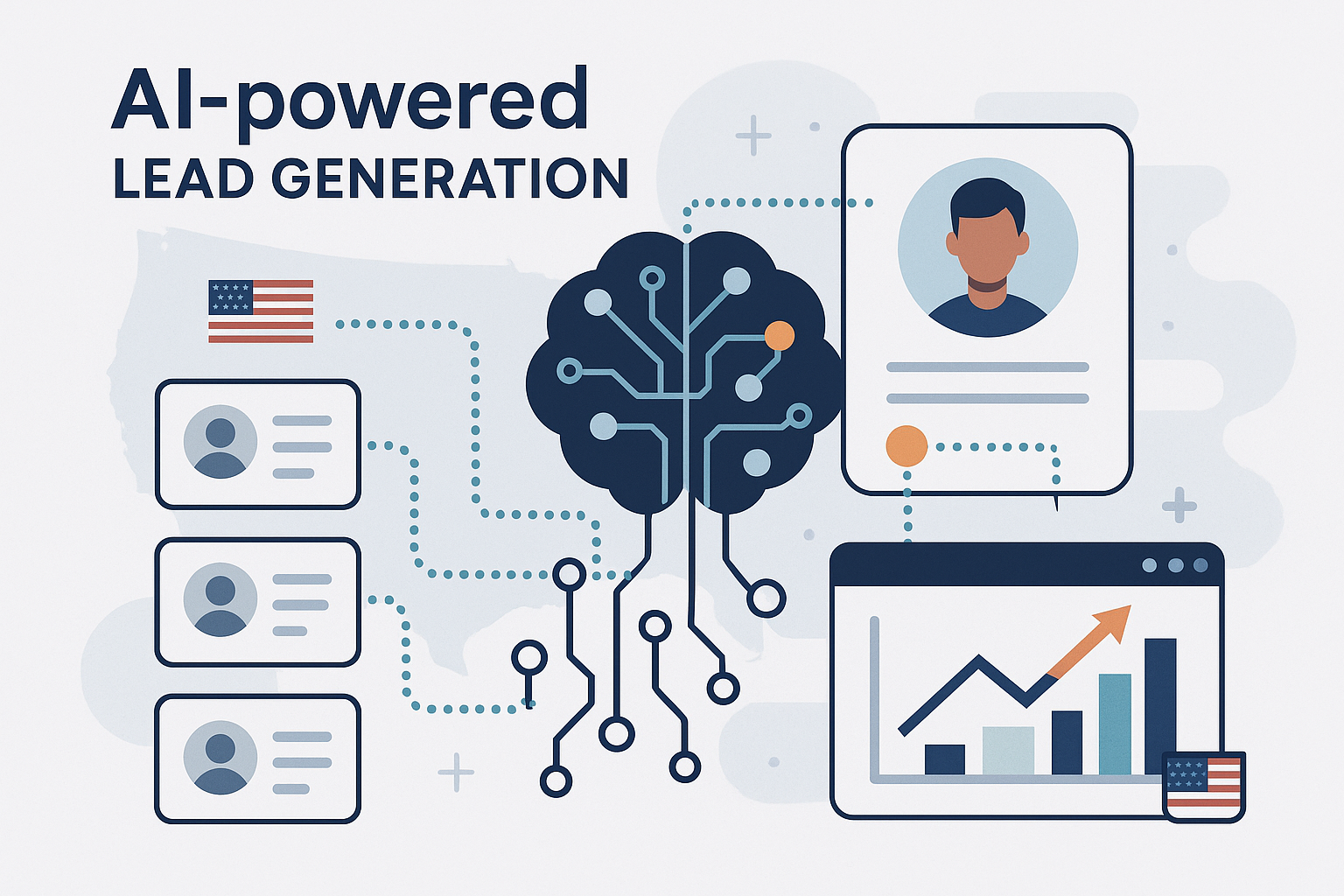
AI-Powered Lead Generation: The Ultimate Guide for 2025
In today’s fast-paced digital landscape, AI-powered lead generation is transforming how U.S. businesses attract, qualify, and convert prospects. Leveraging artificial intelligence, companies can now automate tedious tasks, personalize outreach, and scale their sales pipelines like never before. This comprehensive guide explores the latest strategies, tools, and best practices for mastering AI-powered lead generation in 2025.
What Is AI-Powered Lead Generation?
AI-powered lead generation refers to the use of artificial intelligence technologies—such as machine learning, natural language processing, and predictive analytics—to identify, attract, and nurture potential customers. By automating data analysis and outreach, AI helps businesses find high-quality leads faster and more efficiently.
TIP: AI doesn’t replace human sales teams—it empowers them to focus on high-value interactions by automating repetitive tasks.
Why AI-Powered Lead Generation Matters in 2025
📈 The U.S. Market Is More Competitive Than Ever
With over 33 million businesses in the U.S. as of 2025, standing out and reaching the right prospects is a major challenge. AI-powered lead generation gives companies a competitive edge by:
- Automating lead scoring and prioritization
- Personalizing communication at scale
- Reducing manual research time
- Increasing conversion rates
✅ Key Benefits of AI in Lead Generation
- Efficiency: Automate repetitive tasks and free up your sales team’s time.
- Accuracy: Use data-driven insights to target the right prospects.
- Personalization: Tailor messages based on behavioral and demographic data.
- Scalability: Handle thousands of leads simultaneously without sacrificing quality.
How AI-Powered Lead Generation Works
1. Data Collection and Enrichment
AI tools gather data from multiple sources—social media, websites, CRM systems, and more. They enrich lead profiles with valuable insights such as job titles, company size, and buying intent.
2. Predictive Lead Scoring
Machine learning algorithms analyze historical data to predict which leads are most likely to convert. This helps sales teams focus on high-potential prospects.
3. Automated Outreach
AI-powered platforms can send personalized emails, schedule follow-ups, and even chat with leads via conversational bots.
4. Continuous Learning
AI systems improve over time by learning from outcomes, refining their targeting and messaging strategies.
Top 10 AI-Powered Lead Generation Tools for U.S. Businesses (2025)
Choosing the right tool is crucial for maximizing your ROI. Here’s a ranked list of the top 10 AI-powered lead generation platforms dominating the U.S. market in 2025:
- Salesforce Einstein
- HubSpot AI
- Drift
- ZoomInfo
- Apollo.io
- Leadfeeder
- Cognism
- InsideSales (XANT)
- 6sense
- Lusha
Side-by-Side Comparison Table
| Rank | Tool Name | Best For | Key AI Features | Pricing Tier |
|---|---|---|---|---|
| 1 | Salesforce Einstein | Enterprise CRM Integration | Predictive scoring, automation | Premium |
| 2 | HubSpot AI | SMBs & Enterprises | Chatbots, email personalization | Mid-High |
| 3 | Drift | Conversational Marketing | AI chatbots, lead routing | Mid |
| 4 | ZoomInfo | B2B Data Enrichment | Intent data, predictive analytics | Mid-High |
| 5 | Apollo.io | Sales Engagement | AI-powered prospecting | Mid |
| 6 | Leadfeeder | Website Visitor Tracking | AI lead identification | Mid |
| 7 | Cognism | Global B2B Leads | Intent signals, compliance AI | Mid-High |
| 8 | InsideSales (XANT) | Sales Acceleration | Predictive analytics | Premium |
| 9 | 6sense | Account-Based Marketing | AI-driven insights | Premium |
| 10 | Lusha | Contact Data | AI data enrichment | Low-Mid |
TIP: When selecting a tool, consider your business size, sales process, and integration needs.
Best Practices for Implementing AI-Powered Lead Generation
1. Define Clear Objectives
Set measurable goals such as increasing qualified leads by 30% or reducing lead response time by 50%.
2. Integrate with Existing Systems
Ensure your AI tools connect seamlessly with your CRM, marketing automation, and sales platforms.
3. Train Your Team
Educate your sales and marketing teams on how to leverage AI insights and automation features.
4. Monitor and Optimize
Regularly review performance metrics and adjust your strategies based on AI-driven recommendations.
Real-World Example: AI-Powered Lead Generation in Action
Imagine a U.S.-based SaaS company using AI to analyze website visitor behavior. The AI identifies visitors who spend more than five minutes on the pricing page and automatically sends them a personalized email offering a demo. This targeted approach results in a 40% increase in demo bookings and a 25% boost in conversions.
Common Challenges and How to Overcome Them
Data Quality Issues
AI is only as good as the data it uses. Regularly clean and update your databases to ensure accuracy.
Integration Complexity
Work with IT and vendors to ensure smooth integration with your existing tech stack.
Change Management
Address team concerns by highlighting the benefits of AI and providing ongoing training.
AI-Powered Lead Generation Strategies for 2025
- Intent-Based Targeting: Use AI to identify leads showing buying intent based on online behavior.
- Conversational AI: Deploy chatbots to engage and qualify leads 24/7.
- Predictive Analytics: Forecast which leads are most likely to convert and prioritize outreach.
- Automated Personalization: Tailor messages and offers based on each lead’s profile.
Conclusion
AI-powered lead generation is revolutionizing how U.S. businesses find and convert prospects in 2025. By automating data collection, lead scoring, and personalized outreach, AI enables companies to work smarter, not harder. The key to success lies in choosing the right tools, integrating them with your existing systems, and continuously optimizing your strategies. Embrace AI-powered lead generation to stay ahead of the competition, boost your sales pipeline, and drive sustainable growth in the ever-evolving U.S. market.